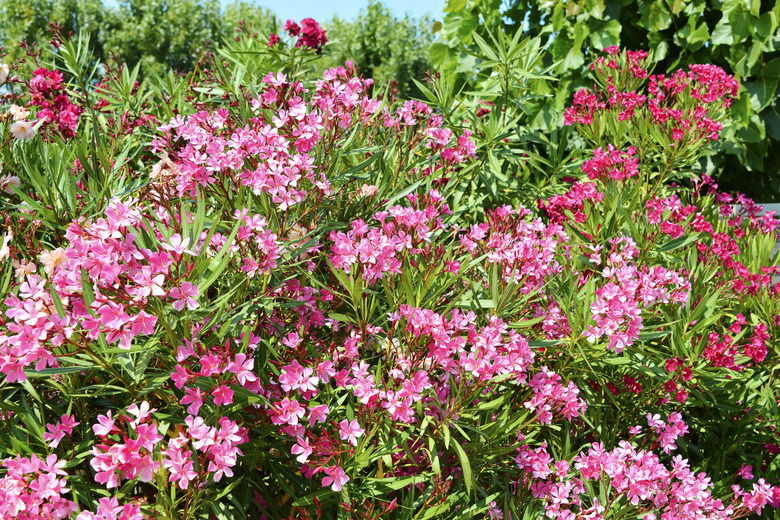How Toxic Is Oleander To Humans?
Oleander (Nerium oleander) is a striking evergreen shrub characterized by long, lance-shaped leaves, a resilient disposition and fragrant blooms in shades of reds, pinks, yellow and white. A native of southwestern Europe and East Asia, oleander can be found growing in sunny sites in U.S. Department of Agriculture plant hardiness zones 8 to 11. While the shrub is beautiful and sounds like a gardener's dream, it's also deadly: Ingesting a single leaf can kill an adult. Due to the plant's extreme toxicity, oleander may not be a suitable shrub for households with small children or pets, and the risk may be too great even in an adults-only home.
All Parts Are Toxic
Oleanders contain two extremely toxic cardiac glycosides, oleandroside and nerioside. These toxic components exist in all parts of the plant, from the leaves to the branches, seeds, flowers and even the flower nectar. Toxins are effective whether the plant is fresh or dry, and honey made from the flowers is also poisonous.
- Oleander (Nerium oleander) is a striking evergreen shrub characterized by long, lance-shaped leaves, a resilient disposition and fragrant blooms in shades of reds, pinks, yellow and white.
- Due to the plant's extreme toxicity, oleander may not be a suitable shrub for households with small children or pets, and the risk may be too great even in an adults-only home.
Ingestion May Be Fatal
Ingesting even a very small piece of the plant may be fatal. People have died from using oleander branches as skewers for meat. Also, children have been poisoned from chewing leaves and sucking nectar from blossoms. Poisoning symptoms may include severe stomach pain, diarrhea, vomiting, nausea, weakness, dizziness and irregular heartbeat. Also, pupils may appear dilated. In the worst case scenario, respiratory paralysis, coma and death occur. Contact your health care provider or call the American Association of Poison Control Centers' free, confidential Poison Help line at 800-222-1222 if you suspect someone has been poisoned by oleander.
- Ingesting even a very small piece of the plant may be fatal.
- Also, children have been poisoned from chewing leaves and sucking nectar from blossoms.
Pets Are at Risk
Oleander is also extremely toxic to cats, dogs and horses. Poisoning symptoms in pets may include colic, sweating, incoordination, difficulty breathing or shallow breathing, and diarrhea, which may turn bloody. Pets may also suffer muscle tremors and be unable to stand up. They may die from cardiac failure. If your pet ingests oleander, contact your veterinarian, or call the ASPCA Animal Poison Control Center at 888-426-4435. The ASPCA may charge a $65 consultation fee.
Protect Yourself When Handling
Simply touching an oleander plant can cause skin irritation, particularly if you come into contact with the plant sap. If you are cultivating an oleander, wear gloves when you prune the shrub, and wash your hands well afterward. Disinfect your pruning shears by soaking your tools in a solution that is equal parts alcohol and water for five minutes. Rinse with water and air dry. Do not burn oleander clippings**,** as the smoke can irritate the eyes and lungs. Do not compost oleander; instead, secure clippings in a bag and throw away.
- Oleander is also extremely toxic to cats, dogs and horses.
- If you are cultivating an oleander, wear gloves when you prune the shrub, and wash your hands well afterward.
References
- Plants for a Future: Nerium Oleander
- North Carolina State University: Nerium Oleander
- The American Society for the Prevention of Cruelty to Animals
- Weed Science Society of America: Oleander
- AAPCC: American Association of Poison Control Centers
- University of Florida Extension: Disinfecting Pruning Tools
- Clemson University Cooperative Extension: Oleander
